Health and Social Care Report: UK Health Policy Developments Analysis
VerifiedAdded on 2022/09/12
|10
|3041
|9
Report
AI Summary
This report provides a comprehensive analysis of the historical and ideological developments of UK health and social care policies, with a specific focus on the impact on older adults and individuals with disabilities. The report begins by outlining the historical context, including the inception of the NHS and the influence of key political eras such as the Thatcher and New Labour periods. It then examines the evolution of policies concerning older adults, from pre-1948 to the present day, highlighting key legislative changes and their impact on healthcare provision. Similarly, the report traces the development of policies related to disability, exploring the evolution of attitudes and approaches across different political periods. The analysis covers critical issues like deinstitutionalization, resource allocation, patient choice, and the role of government in shaping health and social care. The report concludes by synthesizing the key trends and challenges in the UK health and social care landscape, offering insights into the effectiveness of various policies and the need for sustainable resources. The paper uses various sources to show the evolution of the UK health policy and its impact on the older adults and the disabled community.

Running head: HEALTH AND SOCIAL CARE
HEALTH AND SOCIAL CARE
Name of the Student:
Name of the University:
Author note:
HEALTH AND SOCIAL CARE
Name of the Student:
Name of the University:
Author note:
Paraphrase This Document
Need a fresh take? Get an instant paraphrase of this document with our AI Paraphraser
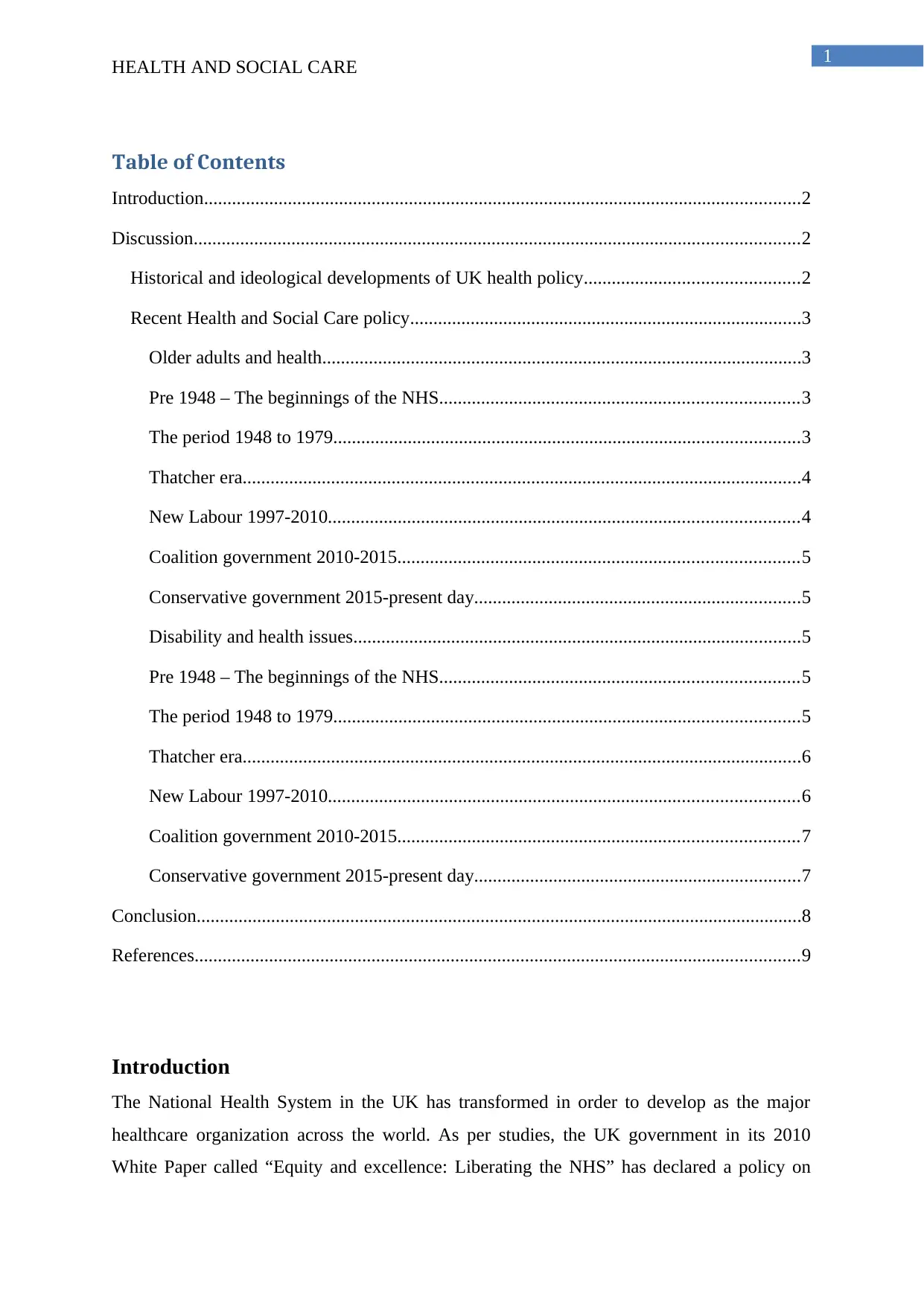
1
HEALTH AND SOCIAL CARE
Table of Contents
Introduction................................................................................................................................2
Discussion..................................................................................................................................2
Historical and ideological developments of UK health policy..............................................2
Recent Health and Social Care policy....................................................................................3
Older adults and health.......................................................................................................3
Pre 1948 – The beginnings of the NHS.............................................................................3
The period 1948 to 1979....................................................................................................3
Thatcher era........................................................................................................................4
New Labour 1997-2010.....................................................................................................4
Coalition government 2010-2015......................................................................................5
Conservative government 2015-present day......................................................................5
Disability and health issues................................................................................................5
Pre 1948 – The beginnings of the NHS.............................................................................5
The period 1948 to 1979....................................................................................................5
Thatcher era........................................................................................................................6
New Labour 1997-2010.....................................................................................................6
Coalition government 2010-2015......................................................................................7
Conservative government 2015-present day......................................................................7
Conclusion..................................................................................................................................8
References..................................................................................................................................9
Introduction
The National Health System in the UK has transformed in order to develop as the major
healthcare organization across the world. As per studies, the UK government in its 2010
White Paper called “Equity and excellence: Liberating the NHS” has declared a policy on
HEALTH AND SOCIAL CARE
Table of Contents
Introduction................................................................................................................................2
Discussion..................................................................................................................................2
Historical and ideological developments of UK health policy..............................................2
Recent Health and Social Care policy....................................................................................3
Older adults and health.......................................................................................................3
Pre 1948 – The beginnings of the NHS.............................................................................3
The period 1948 to 1979....................................................................................................3
Thatcher era........................................................................................................................4
New Labour 1997-2010.....................................................................................................4
Coalition government 2010-2015......................................................................................5
Conservative government 2015-present day......................................................................5
Disability and health issues................................................................................................5
Pre 1948 – The beginnings of the NHS.............................................................................5
The period 1948 to 1979....................................................................................................5
Thatcher era........................................................................................................................6
New Labour 1997-2010.....................................................................................................6
Coalition government 2010-2015......................................................................................7
Conservative government 2015-present day......................................................................7
Conclusion..................................................................................................................................8
References..................................................................................................................................9
Introduction
The National Health System in the UK has transformed in order to develop as the major
healthcare organization across the world. As per studies, the UK government in its 2010
White Paper called “Equity and excellence: Liberating the NHS” has declared a policy on
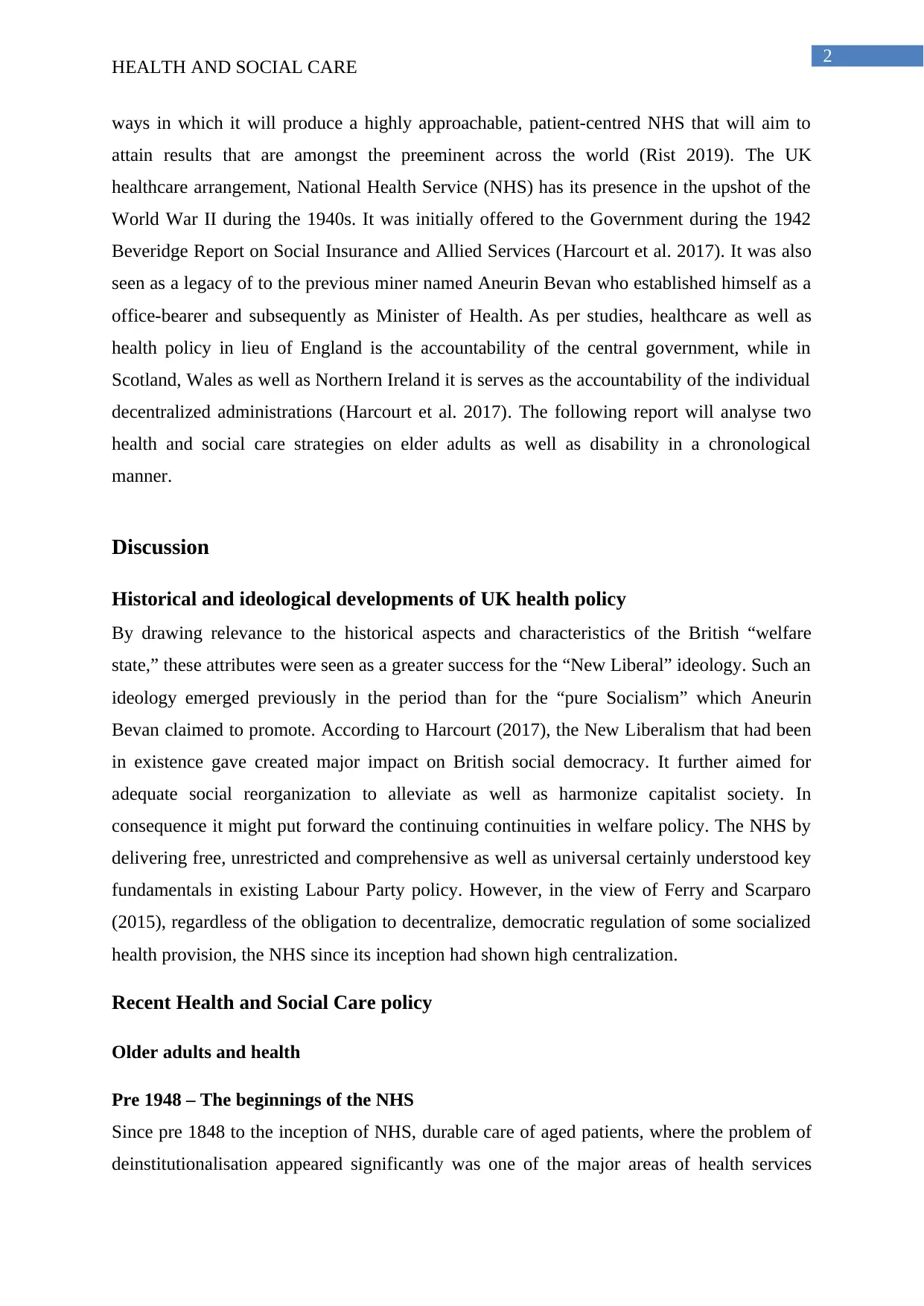
2
HEALTH AND SOCIAL CARE
ways in which it will produce a highly approachable, patient-centred NHS that will aim to
attain results that are amongst the preeminent across the world (Rist 2019). The UK
healthcare arrangement, National Health Service (NHS) has its presence in the upshot of the
World War II during the 1940s. It was initially offered to the Government during the 1942
Beveridge Report on Social Insurance and Allied Services (Harcourt et al. 2017). It was also
seen as a legacy of to the previous miner named Aneurin Bevan who established himself as a
office-bearer and subsequently as Minister of Health. As per studies, healthcare as well as
health policy in lieu of England is the accountability of the central government, while in
Scotland, Wales as well as Northern Ireland it is serves as the accountability of the individual
decentralized administrations (Harcourt et al. 2017). The following report will analyse two
health and social care strategies on elder adults as well as disability in a chronological
manner.
Discussion
Historical and ideological developments of UK health policy
By drawing relevance to the historical aspects and characteristics of the British “welfare
state,” these attributes were seen as a greater success for the “New Liberal” ideology. Such an
ideology emerged previously in the period than for the “pure Socialism” which Aneurin
Bevan claimed to promote. According to Harcourt (2017), the New Liberalism that had been
in existence gave created major impact on British social democracy. It further aimed for
adequate social reorganization to alleviate as well as harmonize capitalist society. In
consequence it might put forward the continuing continuities in welfare policy. The NHS by
delivering free, unrestricted and comprehensive as well as universal certainly understood key
fundamentals in existing Labour Party policy. However, in the view of Ferry and Scarparo
(2015), regardless of the obligation to decentralize, democratic regulation of some socialized
health provision, the NHS since its inception had shown high centralization.
Recent Health and Social Care policy
Older adults and health
Pre 1948 – The beginnings of the NHS
Since pre 1848 to the inception of NHS, durable care of aged patients, where the problem of
deinstitutionalisation appeared significantly was one of the major areas of health services
HEALTH AND SOCIAL CARE
ways in which it will produce a highly approachable, patient-centred NHS that will aim to
attain results that are amongst the preeminent across the world (Rist 2019). The UK
healthcare arrangement, National Health Service (NHS) has its presence in the upshot of the
World War II during the 1940s. It was initially offered to the Government during the 1942
Beveridge Report on Social Insurance and Allied Services (Harcourt et al. 2017). It was also
seen as a legacy of to the previous miner named Aneurin Bevan who established himself as a
office-bearer and subsequently as Minister of Health. As per studies, healthcare as well as
health policy in lieu of England is the accountability of the central government, while in
Scotland, Wales as well as Northern Ireland it is serves as the accountability of the individual
decentralized administrations (Harcourt et al. 2017). The following report will analyse two
health and social care strategies on elder adults as well as disability in a chronological
manner.
Discussion
Historical and ideological developments of UK health policy
By drawing relevance to the historical aspects and characteristics of the British “welfare
state,” these attributes were seen as a greater success for the “New Liberal” ideology. Such an
ideology emerged previously in the period than for the “pure Socialism” which Aneurin
Bevan claimed to promote. According to Harcourt (2017), the New Liberalism that had been
in existence gave created major impact on British social democracy. It further aimed for
adequate social reorganization to alleviate as well as harmonize capitalist society. In
consequence it might put forward the continuing continuities in welfare policy. The NHS by
delivering free, unrestricted and comprehensive as well as universal certainly understood key
fundamentals in existing Labour Party policy. However, in the view of Ferry and Scarparo
(2015), regardless of the obligation to decentralize, democratic regulation of some socialized
health provision, the NHS since its inception had shown high centralization.
Recent Health and Social Care policy
Older adults and health
Pre 1948 – The beginnings of the NHS
Since pre 1848 to the inception of NHS, durable care of aged patients, where the problem of
deinstitutionalisation appeared significantly was one of the major areas of health services
⊘ This is a preview!⊘
Do you want full access?
Subscribe today to unlock all pages.

Trusted by 1+ million students worldwide
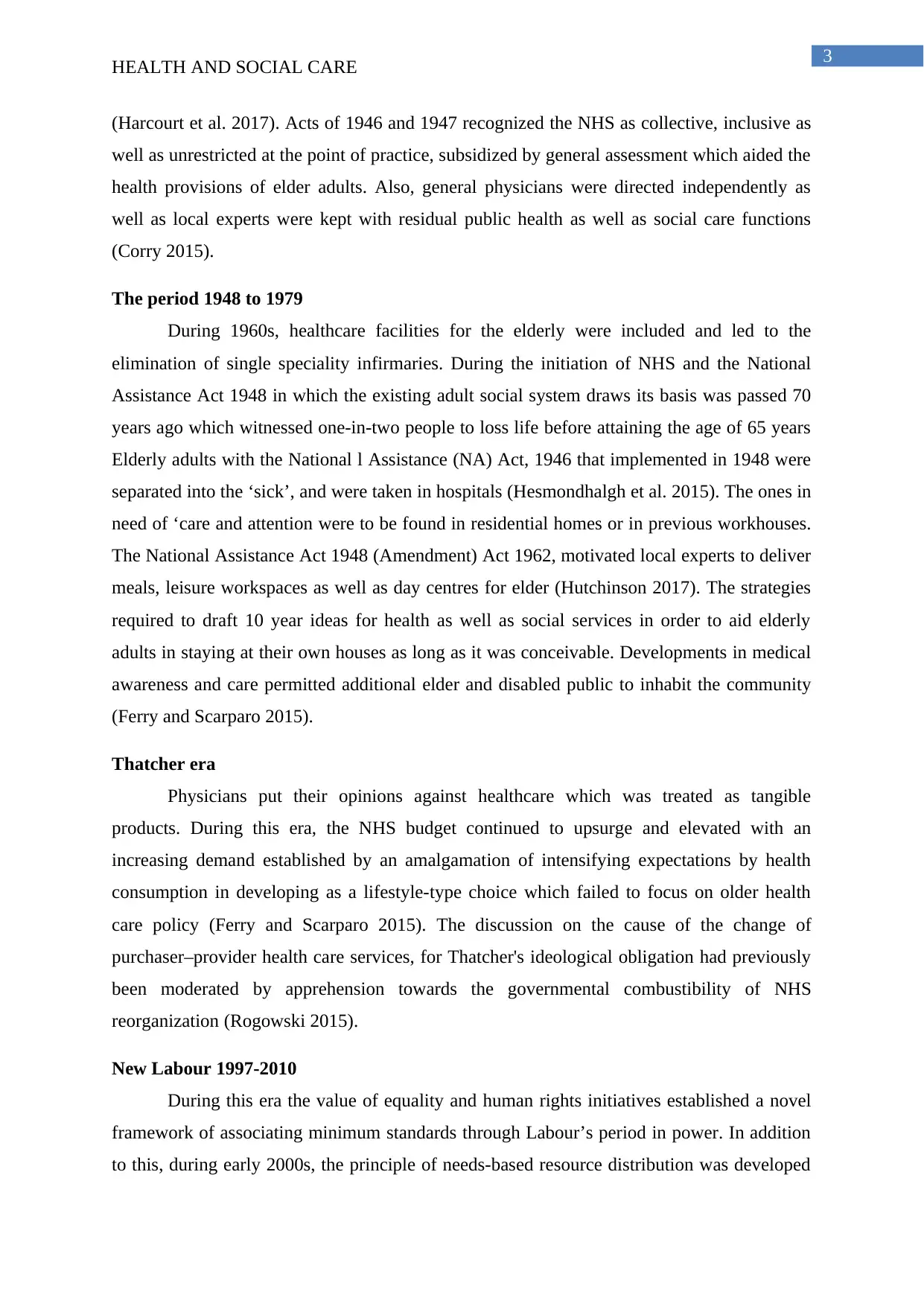
3
HEALTH AND SOCIAL CARE
(Harcourt et al. 2017). Acts of 1946 and 1947 recognized the NHS as collective, inclusive as
well as unrestricted at the point of practice, subsidized by general assessment which aided the
health provisions of elder adults. Also, general physicians were directed independently as
well as local experts were kept with residual public health as well as social care functions
(Corry 2015).
The period 1948 to 1979
During 1960s, healthcare facilities for the elderly were included and led to the
elimination of single speciality infirmaries. During the initiation of NHS and the National
Assistance Act 1948 in which the existing adult social system draws its basis was passed 70
years ago which witnessed one-in-two people to loss life before attaining the age of 65 years
Elderly adults with the National l Assistance (NA) Act, 1946 that implemented in 1948 were
separated into the ‘sick’, and were taken in hospitals (Hesmondhalgh et al. 2015). The ones in
need of ‘care and attention were to be found in residential homes or in previous workhouses.
The National Assistance Act 1948 (Amendment) Act 1962, motivated local experts to deliver
meals, leisure workspaces as well as day centres for elder (Hutchinson 2017). The strategies
required to draft 10 year ideas for health as well as social services in order to aid elderly
adults in staying at their own houses as long as it was conceivable. Developments in medical
awareness and care permitted additional elder and disabled public to inhabit the community
(Ferry and Scarparo 2015).
Thatcher era
Physicians put their opinions against healthcare which was treated as tangible
products. During this era, the NHS budget continued to upsurge and elevated with an
increasing demand established by an amalgamation of intensifying expectations by health
consumption in developing as a lifestyle-type choice which failed to focus on older health
care policy (Ferry and Scarparo 2015). The discussion on the cause of the change of
purchaser–provider health care services, for Thatcher's ideological obligation had previously
been moderated by apprehension towards the governmental combustibility of NHS
reorganization (Rogowski 2015).
New Labour 1997-2010
During this era the value of equality and human rights initiatives established a novel
framework of associating minimum standards through Labour’s period in power. In addition
to this, during early 2000s, the principle of needs-based resource distribution was developed
HEALTH AND SOCIAL CARE
(Harcourt et al. 2017). Acts of 1946 and 1947 recognized the NHS as collective, inclusive as
well as unrestricted at the point of practice, subsidized by general assessment which aided the
health provisions of elder adults. Also, general physicians were directed independently as
well as local experts were kept with residual public health as well as social care functions
(Corry 2015).
The period 1948 to 1979
During 1960s, healthcare facilities for the elderly were included and led to the
elimination of single speciality infirmaries. During the initiation of NHS and the National
Assistance Act 1948 in which the existing adult social system draws its basis was passed 70
years ago which witnessed one-in-two people to loss life before attaining the age of 65 years
Elderly adults with the National l Assistance (NA) Act, 1946 that implemented in 1948 were
separated into the ‘sick’, and were taken in hospitals (Hesmondhalgh et al. 2015). The ones in
need of ‘care and attention were to be found in residential homes or in previous workhouses.
The National Assistance Act 1948 (Amendment) Act 1962, motivated local experts to deliver
meals, leisure workspaces as well as day centres for elder (Hutchinson 2017). The strategies
required to draft 10 year ideas for health as well as social services in order to aid elderly
adults in staying at their own houses as long as it was conceivable. Developments in medical
awareness and care permitted additional elder and disabled public to inhabit the community
(Ferry and Scarparo 2015).
Thatcher era
Physicians put their opinions against healthcare which was treated as tangible
products. During this era, the NHS budget continued to upsurge and elevated with an
increasing demand established by an amalgamation of intensifying expectations by health
consumption in developing as a lifestyle-type choice which failed to focus on older health
care policy (Ferry and Scarparo 2015). The discussion on the cause of the change of
purchaser–provider health care services, for Thatcher's ideological obligation had previously
been moderated by apprehension towards the governmental combustibility of NHS
reorganization (Rogowski 2015).
New Labour 1997-2010
During this era the value of equality and human rights initiatives established a novel
framework of associating minimum standards through Labour’s period in power. In addition
to this, during early 2000s, the principle of needs-based resource distribution was developed
Paraphrase This Document
Need a fresh take? Get an instant paraphrase of this document with our AI Paraphraser

4
HEALTH AND SOCIAL CARE
as well as extended, with the introduction of a new health inequalities constituent to the
funding formula for older adults (World Health Organization 2015). During Labour’s
movement, there was an additional modification to reinforce the principle of impartial, needs-
based resource provision (Hesmondhalgh et al. 2015). The pre-existing necessities founded
formula owed reserves to endorse the purpose of equivalent access to healthcare for aged
people at equal possibility.
Coalition government 2010-2015
The coalition government envisioned to endorse the ideology of serving patient
choice as well as competition, reliable with a broader certainty in competition in community
services as a driver of development (Mattheys 2015). In addition to this, improving as well as
underlining the valuable aids that elder people make to society as well as economy, refining
their liberation and also establishing harmony between age group have been seen as the
objectives in this era.
Conservative government 2015-present day
In the current era, it is evident that demand on primary and has been community care
elevating through an amalgamation of: increasing numbers of individuals living with long-
term health illnesses and rising numbers of fragile older people with intricate health needs
(World Health Organization 2015).
Disability and health issues
Pre 1948 – The beginnings of the NHS
The genesis of the NHS can be dated back in the 19th Century. During that era few
had the ideology of accessing to health care as part of the organization of an urbane society.
The foundation of NHS was based on the principle that every individual has equal rights of
attaining health services (Dagnan et al. 2015). The foundation of the NHS principally focused
on groups of patients who habitually had a deprived arrangement. The disabled people were
often viewed as the subjects of reports, at times subsequent to disgraces.
The period 1948 to 1979
This era highlighted activities of the Disablement Income Group (DIG) and their
implications on the development of disability onto the policy stage in the mid-1960s. With
the establishment of the Poor Law Act of 1601, the Act made it an obligation of local
communities to deliver assistance to the impotent underprivileged (Hemingway et al. 2015).
HEALTH AND SOCIAL CARE
as well as extended, with the introduction of a new health inequalities constituent to the
funding formula for older adults (World Health Organization 2015). During Labour’s
movement, there was an additional modification to reinforce the principle of impartial, needs-
based resource provision (Hesmondhalgh et al. 2015). The pre-existing necessities founded
formula owed reserves to endorse the purpose of equivalent access to healthcare for aged
people at equal possibility.
Coalition government 2010-2015
The coalition government envisioned to endorse the ideology of serving patient
choice as well as competition, reliable with a broader certainty in competition in community
services as a driver of development (Mattheys 2015). In addition to this, improving as well as
underlining the valuable aids that elder people make to society as well as economy, refining
their liberation and also establishing harmony between age group have been seen as the
objectives in this era.
Conservative government 2015-present day
In the current era, it is evident that demand on primary and has been community care
elevating through an amalgamation of: increasing numbers of individuals living with long-
term health illnesses and rising numbers of fragile older people with intricate health needs
(World Health Organization 2015).
Disability and health issues
Pre 1948 – The beginnings of the NHS
The genesis of the NHS can be dated back in the 19th Century. During that era few
had the ideology of accessing to health care as part of the organization of an urbane society.
The foundation of NHS was based on the principle that every individual has equal rights of
attaining health services (Dagnan et al. 2015). The foundation of the NHS principally focused
on groups of patients who habitually had a deprived arrangement. The disabled people were
often viewed as the subjects of reports, at times subsequent to disgraces.
The period 1948 to 1979
This era highlighted activities of the Disablement Income Group (DIG) and their
implications on the development of disability onto the policy stage in the mid-1960s. With
the establishment of the Poor Law Act of 1601, the Act made it an obligation of local
communities to deliver assistance to the impotent underprivileged (Hemingway et al. 2015).

5
HEALTH AND SOCIAL CARE
In this era, disabled public showed reliance on non-statutory provision. However, an overall
payment for disabled people was disallowed by the Labour government based as it
destabilized the contributory principle of National Insurance (Appleby and Robertson 2016).
Thatcher era
The arrangement of policies applied during the Thatcher era resulted in a rapid rise in
rates of job redundancy. Since 1980, the sum of unemployment applicants increased from
nearly 1 million to 3 million in 1983 along with an extensive peak which was witnessed in
the early 1990s. On the other hand, there was a balanced rise in the amount of supplicants of
long-term disability benefits. Additionally, the elevation in the total of disability benefit
applicants was attributed to the purpose of the government in removing people from the
unemployment register (Dwyer 2017). This policy reflected the ideological conviction in the
dominance of the market and was prevalent amongst wide range of disabled people in
housing market crash that occurred in 1989. This ideology and principle of Thatcher caused
several homeowners to encounter inequality in health provisions and contributed to growing
wealth inequalities (Appleby et al. 2015).
New Labour 1997-2010
New Labour presented the policy agenda as non-ideological which has been
pragmatic instead of being dogmatic. It has developed more radical challenges to the current
disability policy agenda in addition has engaged in wider debates, predominantly with the
ones which pose queries on the ongoing pursuit of financial development irrespective of the
impairment done to the situation as well as to values and to the humanity (Corry 2015). This
period also emphasised health provision rights of disabled people to autonomy as well as self-
determination that reflected the Conservative Government’s agenda. It further drew
consideration to an approach which could stabilize the lack of choice as well as control that
are destabilizing human rights (Ferry and Scarparo 2015).
Coalition government 2010-2015
By drawing relevance to the step-change that has been in progress in the
marketization of the NHS as well as other public services, the coalition government has
offered an ideologically radical view as those of Thatcher and Attlee. During this period, with
health aid protections, majority of the departments’ finances have been lessened by nearly a
fifth between 2010 and 2015. According to studies, the 4% real terms reduction in all benefits
as well as tax credits since the following three years led to the change of disability living
HEALTH AND SOCIAL CARE
In this era, disabled public showed reliance on non-statutory provision. However, an overall
payment for disabled people was disallowed by the Labour government based as it
destabilized the contributory principle of National Insurance (Appleby and Robertson 2016).
Thatcher era
The arrangement of policies applied during the Thatcher era resulted in a rapid rise in
rates of job redundancy. Since 1980, the sum of unemployment applicants increased from
nearly 1 million to 3 million in 1983 along with an extensive peak which was witnessed in
the early 1990s. On the other hand, there was a balanced rise in the amount of supplicants of
long-term disability benefits. Additionally, the elevation in the total of disability benefit
applicants was attributed to the purpose of the government in removing people from the
unemployment register (Dwyer 2017). This policy reflected the ideological conviction in the
dominance of the market and was prevalent amongst wide range of disabled people in
housing market crash that occurred in 1989. This ideology and principle of Thatcher caused
several homeowners to encounter inequality in health provisions and contributed to growing
wealth inequalities (Appleby et al. 2015).
New Labour 1997-2010
New Labour presented the policy agenda as non-ideological which has been
pragmatic instead of being dogmatic. It has developed more radical challenges to the current
disability policy agenda in addition has engaged in wider debates, predominantly with the
ones which pose queries on the ongoing pursuit of financial development irrespective of the
impairment done to the situation as well as to values and to the humanity (Corry 2015). This
period also emphasised health provision rights of disabled people to autonomy as well as self-
determination that reflected the Conservative Government’s agenda. It further drew
consideration to an approach which could stabilize the lack of choice as well as control that
are destabilizing human rights (Ferry and Scarparo 2015).
Coalition government 2010-2015
By drawing relevance to the step-change that has been in progress in the
marketization of the NHS as well as other public services, the coalition government has
offered an ideologically radical view as those of Thatcher and Attlee. During this period, with
health aid protections, majority of the departments’ finances have been lessened by nearly a
fifth between 2010 and 2015. According to studies, the 4% real terms reduction in all benefits
as well as tax credits since the following three years led to the change of disability living
⊘ This is a preview!⊘
Do you want full access?
Subscribe today to unlock all pages.

Trusted by 1+ million students worldwide
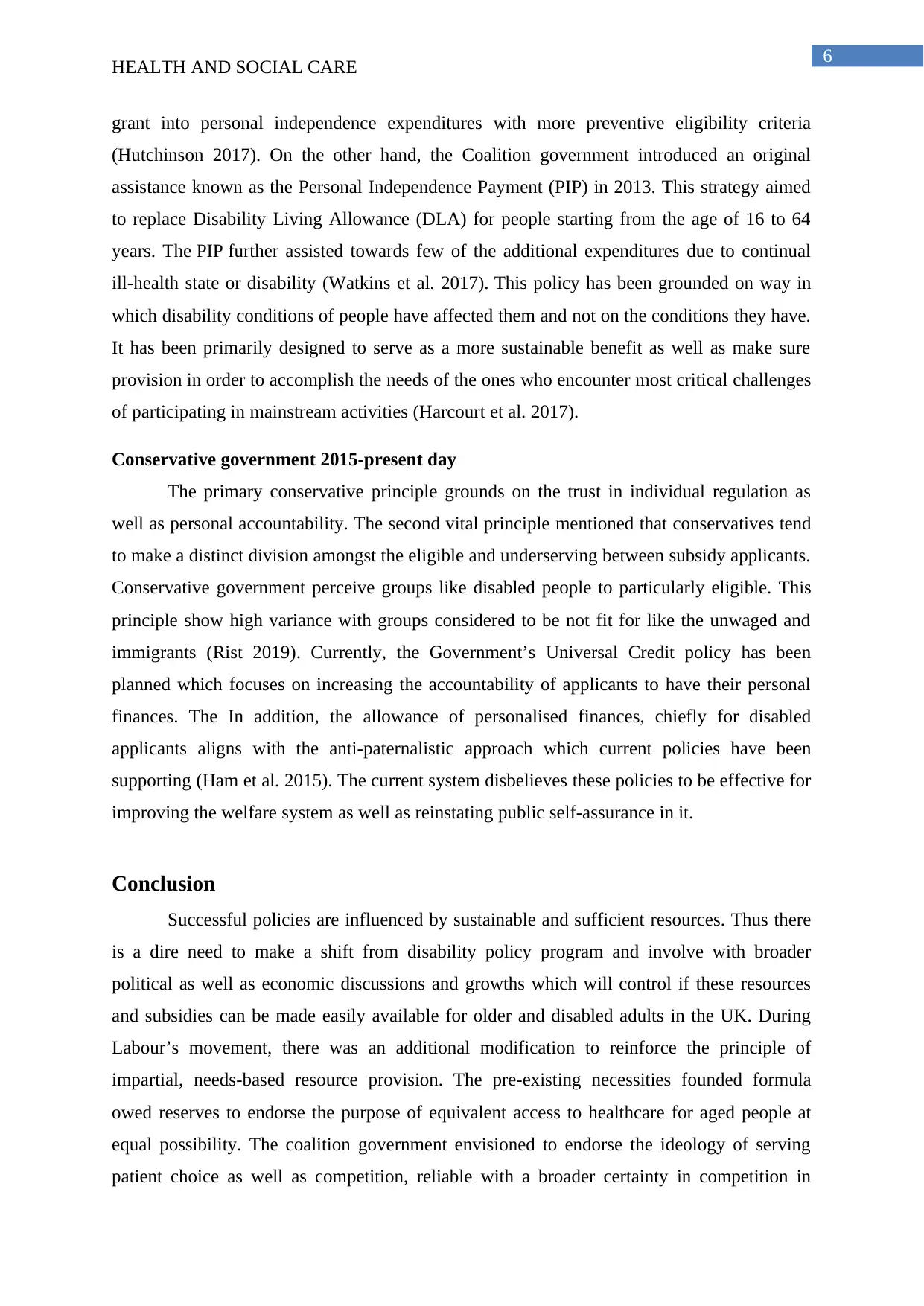
6
HEALTH AND SOCIAL CARE
grant into personal independence expenditures with more preventive eligibility criteria
(Hutchinson 2017). On the other hand, the Coalition government introduced an original
assistance known as the Personal Independence Payment (PIP) in 2013. This strategy aimed
to replace Disability Living Allowance (DLA) for people starting from the age of 16 to 64
years. The PIP further assisted towards few of the additional expenditures due to continual
ill-health state or disability (Watkins et al. 2017). This policy has been grounded on way in
which disability conditions of people have affected them and not on the conditions they have.
It has been primarily designed to serve as a more sustainable benefit as well as make sure
provision in order to accomplish the needs of the ones who encounter most critical challenges
of participating in mainstream activities (Harcourt et al. 2017).
Conservative government 2015-present day
The primary conservative principle grounds on the trust in individual regulation as
well as personal accountability. The second vital principle mentioned that conservatives tend
to make a distinct division amongst the eligible and underserving between subsidy applicants.
Conservative government perceive groups like disabled people to particularly eligible. This
principle show high variance with groups considered to be not fit for like the unwaged and
immigrants (Rist 2019). Currently, the Government’s Universal Credit policy has been
planned which focuses on increasing the accountability of applicants to have their personal
finances. The In addition, the allowance of personalised finances, chiefly for disabled
applicants aligns with the anti-paternalistic approach which current policies have been
supporting (Ham et al. 2015). The current system disbelieves these policies to be effective for
improving the welfare system as well as reinstating public self-assurance in it.
Conclusion
Successful policies are influenced by sustainable and sufficient resources. Thus there
is a dire need to make a shift from disability policy program and involve with broader
political as well as economic discussions and growths which will control if these resources
and subsidies can be made easily available for older and disabled adults in the UK. During
Labour’s movement, there was an additional modification to reinforce the principle of
impartial, needs-based resource provision. The pre-existing necessities founded formula
owed reserves to endorse the purpose of equivalent access to healthcare for aged people at
equal possibility. The coalition government envisioned to endorse the ideology of serving
patient choice as well as competition, reliable with a broader certainty in competition in
HEALTH AND SOCIAL CARE
grant into personal independence expenditures with more preventive eligibility criteria
(Hutchinson 2017). On the other hand, the Coalition government introduced an original
assistance known as the Personal Independence Payment (PIP) in 2013. This strategy aimed
to replace Disability Living Allowance (DLA) for people starting from the age of 16 to 64
years. The PIP further assisted towards few of the additional expenditures due to continual
ill-health state or disability (Watkins et al. 2017). This policy has been grounded on way in
which disability conditions of people have affected them and not on the conditions they have.
It has been primarily designed to serve as a more sustainable benefit as well as make sure
provision in order to accomplish the needs of the ones who encounter most critical challenges
of participating in mainstream activities (Harcourt et al. 2017).
Conservative government 2015-present day
The primary conservative principle grounds on the trust in individual regulation as
well as personal accountability. The second vital principle mentioned that conservatives tend
to make a distinct division amongst the eligible and underserving between subsidy applicants.
Conservative government perceive groups like disabled people to particularly eligible. This
principle show high variance with groups considered to be not fit for like the unwaged and
immigrants (Rist 2019). Currently, the Government’s Universal Credit policy has been
planned which focuses on increasing the accountability of applicants to have their personal
finances. The In addition, the allowance of personalised finances, chiefly for disabled
applicants aligns with the anti-paternalistic approach which current policies have been
supporting (Ham et al. 2015). The current system disbelieves these policies to be effective for
improving the welfare system as well as reinstating public self-assurance in it.
Conclusion
Successful policies are influenced by sustainable and sufficient resources. Thus there
is a dire need to make a shift from disability policy program and involve with broader
political as well as economic discussions and growths which will control if these resources
and subsidies can be made easily available for older and disabled adults in the UK. During
Labour’s movement, there was an additional modification to reinforce the principle of
impartial, needs-based resource provision. The pre-existing necessities founded formula
owed reserves to endorse the purpose of equivalent access to healthcare for aged people at
equal possibility. The coalition government envisioned to endorse the ideology of serving
patient choice as well as competition, reliable with a broader certainty in competition in
Paraphrase This Document
Need a fresh take? Get an instant paraphrase of this document with our AI Paraphraser

7
HEALTH AND SOCIAL CARE
community services as a driver of development. Advances in medical knowledge and care
enabled more older and disabled people to live in the community. Currently, it is evident that
demand on primary and has been community care elevating through an amalgamation of:
increasing numbers of individuals living with long-term health illnesses and rising numbers
of fragile older people.
HEALTH AND SOCIAL CARE
community services as a driver of development. Advances in medical knowledge and care
enabled more older and disabled people to live in the community. Currently, it is evident that
demand on primary and has been community care elevating through an amalgamation of:
increasing numbers of individuals living with long-term health illnesses and rising numbers
of fragile older people.

8
HEALTH AND SOCIAL CARE
References
Appleby, J. and Robertson, R., 2016. Public satisfaction with the NHS in 2015. The King’s
Fund.
Appleby, J., Baird, B., Thompson, J. and Jabbal, J., 2015. The NHS under the coalition
government. Part two: NHS performance. London: The King’s Fund.
Corry, D., 2015. UK Economic Performance Under New Labour 1997–2010: Facts, Lessons
and Pointers. In The British Growth Crisis (pp. 43-76). Palgrave Macmillan, London.
Dagnan, D., Masson, J., Cavagin, A., Thwaites, R. and Hatton, C., 2015. The development of
a measure of confidence in delivering therapy to people with intellectual disabilities. Clinical
psychology & psychotherapy, 22(5), pp.392-398.
Dwyer, P., 2017. Rewriting the contract? Conditionality, welfare reform and the rights and
responsibilities of disabled people. Social policy in an era of competition: from global to
local perspectives, pp.135-148.
Ferry, L. and Scarparo, S., 2015. An era of governance through performance management–
New Labour's National Health Service from 1997 to 2010. Accounting History Review, 25(3),
pp.219-238.
Ham, C., Baird, B., Gregory, S., Jabbal, J. and Alderwick, H., 2015. The NHS under the
coalition government. Part one: NHS reform. London: The King’s Fund.
Harcourt, S.E., Morbey, R.A., Loveridge, P., Carrilho, L., Baynham, D., Povey, E., Fox, P.,
Rutter, J., Moores, P., Tiffen, J. and Bellerby, S., 2017. Developing and validating a new
national remote health advice syndromic surveillance system in England. Journal of Public
Health, 39(1), pp.184-192.
Hemingway, S., Stephenson, J., Trotter, F., Clifton, A. and Holdich, P., 2015. Increasing the
health literacy of learning disability and mental health nurses in physical care skills: a pre and
post-test evaluation of a workshop on diabetes care. Nurse Education in Practice, 15(1),
pp.30-37.
Hesmondhalgh, D., Nisbett, M., Oakley, K. and Lee, D., 2015. Were New Labour’s cultural
policies neo-liberal?. International journal of cultural policy, 21(1), pp.97-114.
Hutchinson, S., 2017. Protecting the legacy: developing a Labour vision for health and social
care. Renewal: a Journal of Labour Politics, 25(3/4), pp.121-127.
Mattheys, K., 2015. The coalition, austerity and mental health. Disability & Society, 30(3),
pp.475-478.
HEALTH AND SOCIAL CARE
References
Appleby, J. and Robertson, R., 2016. Public satisfaction with the NHS in 2015. The King’s
Fund.
Appleby, J., Baird, B., Thompson, J. and Jabbal, J., 2015. The NHS under the coalition
government. Part two: NHS performance. London: The King’s Fund.
Corry, D., 2015. UK Economic Performance Under New Labour 1997–2010: Facts, Lessons
and Pointers. In The British Growth Crisis (pp. 43-76). Palgrave Macmillan, London.
Dagnan, D., Masson, J., Cavagin, A., Thwaites, R. and Hatton, C., 2015. The development of
a measure of confidence in delivering therapy to people with intellectual disabilities. Clinical
psychology & psychotherapy, 22(5), pp.392-398.
Dwyer, P., 2017. Rewriting the contract? Conditionality, welfare reform and the rights and
responsibilities of disabled people. Social policy in an era of competition: from global to
local perspectives, pp.135-148.
Ferry, L. and Scarparo, S., 2015. An era of governance through performance management–
New Labour's National Health Service from 1997 to 2010. Accounting History Review, 25(3),
pp.219-238.
Ham, C., Baird, B., Gregory, S., Jabbal, J. and Alderwick, H., 2015. The NHS under the
coalition government. Part one: NHS reform. London: The King’s Fund.
Harcourt, S.E., Morbey, R.A., Loveridge, P., Carrilho, L., Baynham, D., Povey, E., Fox, P.,
Rutter, J., Moores, P., Tiffen, J. and Bellerby, S., 2017. Developing and validating a new
national remote health advice syndromic surveillance system in England. Journal of Public
Health, 39(1), pp.184-192.
Hemingway, S., Stephenson, J., Trotter, F., Clifton, A. and Holdich, P., 2015. Increasing the
health literacy of learning disability and mental health nurses in physical care skills: a pre and
post-test evaluation of a workshop on diabetes care. Nurse Education in Practice, 15(1),
pp.30-37.
Hesmondhalgh, D., Nisbett, M., Oakley, K. and Lee, D., 2015. Were New Labour’s cultural
policies neo-liberal?. International journal of cultural policy, 21(1), pp.97-114.
Hutchinson, S., 2017. Protecting the legacy: developing a Labour vision for health and social
care. Renewal: a Journal of Labour Politics, 25(3/4), pp.121-127.
Mattheys, K., 2015. The coalition, austerity and mental health. Disability & Society, 30(3),
pp.475-478.
⊘ This is a preview!⊘
Do you want full access?
Subscribe today to unlock all pages.

Trusted by 1+ million students worldwide
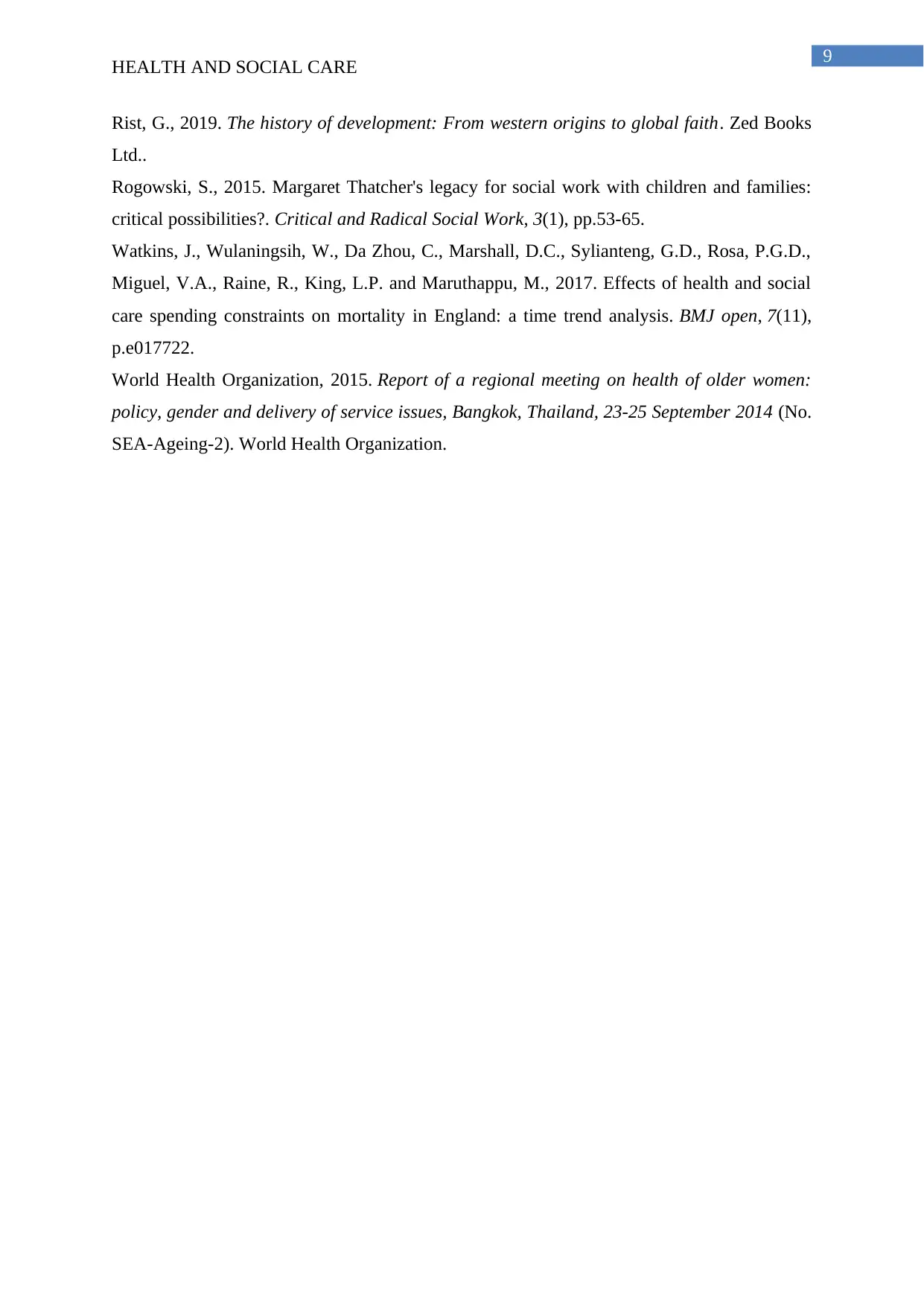
9
HEALTH AND SOCIAL CARE
Rist, G., 2019. The history of development: From western origins to global faith. Zed Books
Ltd..
Rogowski, S., 2015. Margaret Thatcher's legacy for social work with children and families:
critical possibilities?. Critical and Radical Social Work, 3(1), pp.53-65.
Watkins, J., Wulaningsih, W., Da Zhou, C., Marshall, D.C., Sylianteng, G.D., Rosa, P.G.D.,
Miguel, V.A., Raine, R., King, L.P. and Maruthappu, M., 2017. Effects of health and social
care spending constraints on mortality in England: a time trend analysis. BMJ open, 7(11),
p.e017722.
World Health Organization, 2015. Report of a regional meeting on health of older women:
policy, gender and delivery of service issues, Bangkok, Thailand, 23-25 September 2014 (No.
SEA-Ageing-2). World Health Organization.
HEALTH AND SOCIAL CARE
Rist, G., 2019. The history of development: From western origins to global faith. Zed Books
Ltd..
Rogowski, S., 2015. Margaret Thatcher's legacy for social work with children and families:
critical possibilities?. Critical and Radical Social Work, 3(1), pp.53-65.
Watkins, J., Wulaningsih, W., Da Zhou, C., Marshall, D.C., Sylianteng, G.D., Rosa, P.G.D.,
Miguel, V.A., Raine, R., King, L.P. and Maruthappu, M., 2017. Effects of health and social
care spending constraints on mortality in England: a time trend analysis. BMJ open, 7(11),
p.e017722.
World Health Organization, 2015. Report of a regional meeting on health of older women:
policy, gender and delivery of service issues, Bangkok, Thailand, 23-25 September 2014 (No.
SEA-Ageing-2). World Health Organization.
1 out of 10
Your All-in-One AI-Powered Toolkit for Academic Success.
+13062052269
info@desklib.com
Available 24*7 on WhatsApp / Email
![[object Object]](/_next/static/media/star-bottom.7253800d.svg)
Unlock your academic potential
Copyright © 2020–2025 A2Z Services. All Rights Reserved. Developed and managed by ZUCOL.


